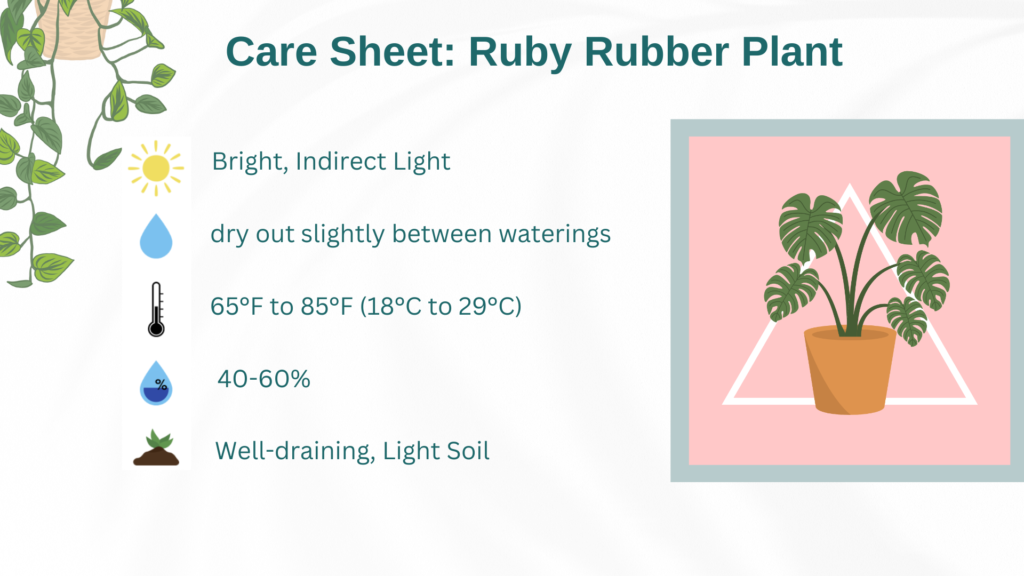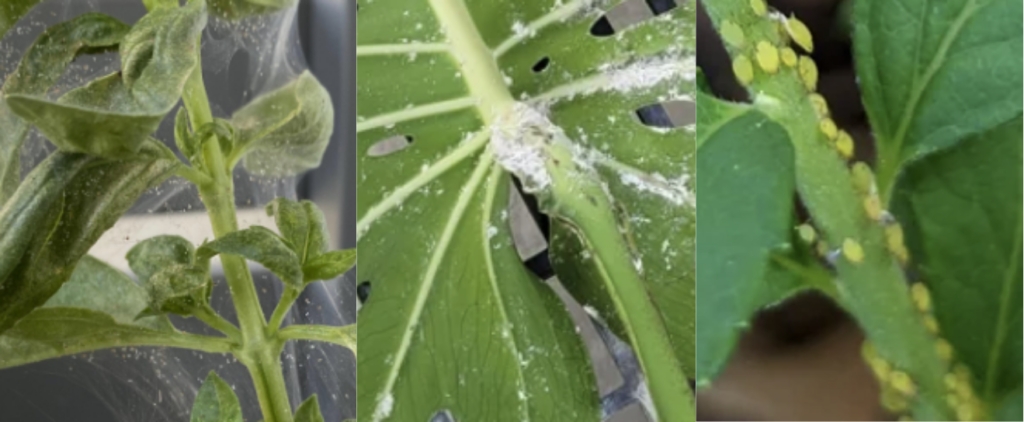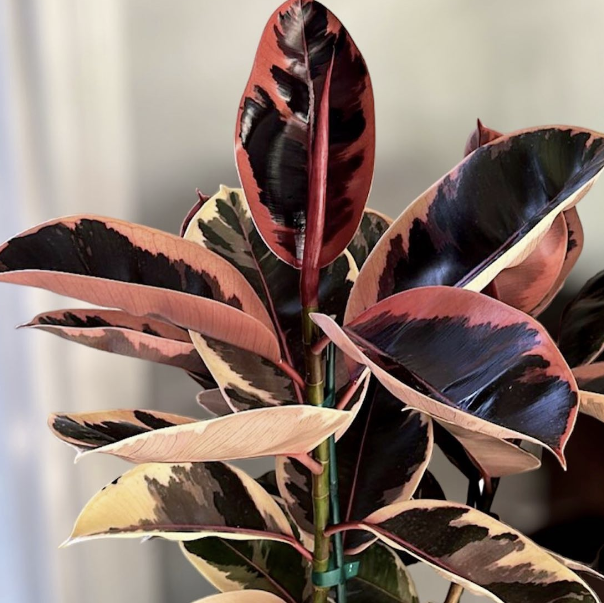The Ruby Rubber Plant (Ficus elastica ‘Ruby’) is a gorgeous, easy-to-grow houseplant known for its striking, red-tinted leaves and hardy nature.
This plant has gained popularity not only for its beauty but also because it’s relatively low-maintenance, making it a great choice for beginners and seasoned plant lovers alike.
If you want a plant that’s both eye-catching and easy to care for, the Ruby Rubber Plant is a fantastic option. Let’s dive into how to care for this lovely plant and make it thrive!
Why is it called the Ruby Rubber Plant?
The Ruby Rubber Plant gets its name from its distinct, ruby-red and pink leaves. It belongs to the rubber plant family (Ficus elastica), which originally earned its name because the plant’s sap was once used to make rubber.
Unlike typical rubber plants, though, this variety has beautiful red hues, giving it a unique look that stands out in any space.
How to Identify a Ruby Rubber Plant
The Ruby Rubber Plant has large, oval-shaped leaves with a mix of green, white, and pinkish-red variegation. The bold colors make it easy to spot. New leaves often start with a deeper red or pink shade, while older leaves will be a blend of green, cream, and sometimes pink. It’s easy to confuse the Ruby with other rubber plant varieties like ‘Tineke,’ but the Ruby’s reddish tones make it stand out.
Size
Ruby Rubber Plants can grow pretty large indoors, typically reaching 2-6 feet in height, depending on the pot size and care. Their large, glossy leaves add a lush, tropical feel, making them an impressive plant for living rooms or bedrooms.
Care

Light Requirements
Ruby Rubber Plants love bright, indirect light to maintain their vibrant colors. Too little light can cause the colors to fade, while too much direct sunlight can scorch the leaves.
Pro Tip: Place your plant near a south- or east-facing window to get plenty of bright but filtered light. If the colors start looking dull, it might be time to move the plant to a brighter spot.
Watering Needs
The Ruby Rubber Plant prefers to dry out slightly between waterings. Overwatering is one of the most common mistakes with this plant, as it can lead to root rot.
- Water when the top inch of soil feels dry. This is usually about once a week in warmer months and once every 2-3 weeks in winter.
- Use room-temperature, filtered water if possible to prevent any shock to the plant.
Pro Tip: If you’re unsure, it’s better to underwater slightly than to overwater. Look for leaves curling inward if the plant needs water, or leaves dropping off if it’s been overwatered.
Temperature and Humidity
This plant loves warm, humid environments. Temperatures between 65°F and 85°F are ideal. Keep it away from cold drafts or sudden temperature changes, which can stress the plant.
Humidity
While the Ruby Rubber Plant can adapt to average indoor humidity, around 40-60%. It does appreciate a bit more moisture in the air, especially in winter when indoor air gets dry.
- Use a humidifier or place a humidity tray (a shallow dish filled with water and pebbles) nearby.
- Misting the leaves occasionally can also help, but avoid doing this too frequently as overly wet leaves can lead to fungal issues.
Soil Requirements
The Ruby Rubber Plant needs well-draining, light soil to prevent root rot. A cactus or succulent mix works well, or you can add perlite or sand to regular potting soil to improve drainage.
Fertilizer
During the growing season (spring and summer), feed your Ruby Rubber Plant with a balanced, water-soluble fertilizer every 4-6 weeks. Avoid fertilizing in the fall and winter when the plant’s growth slows down.
Potting
Choose a pot with drainage holes to prevent water from pooling at the bottom. Repot every 1-2 years, preferably in spring, to refresh the soil and give the plant more space if it’s outgrowing its pot.
Pro Tip: When repotting, go up just one pot size to avoid overwhelming the plant with too much new soil, which can hold too much moisture.
Pruning
Pruning is not necessary for the Ruby Rubber Plant, but trimming it occasionally can help keep it bushy and compact. You can prune back any leggy stems to encourage more branching.
Pro Tip: If you cut a stem, you might notice a white, milky sap. This sap can be irritating, so wear gloves when pruning and avoid touching your face.
Propagation
The easiest way to propagate a Ruby Rubber Plant is through stem cuttings.
- Take a 4-6 inch stem cutting just below a node.
- Let the cutting dry for a few hours to seal the cut end.
- Place it in a small pot with fresh soil or water until roots form.
- Keep the cutting in indirect light and mist it occasionally.
Pests
Though generally hardy, Ruby Rubber Plants can occasionally attract pests like spider mites, scale, and mealybugs.
- Spider Mites: Look for tiny webs on the leaves. Use a damp cloth to wipe the leaves or spray with insecticidal soap.
- Mealybugs: These white, cotton-like bugs usually hide in leaf crevices. Use insecticidal soap or a cotton swab dipped in alcohol to wipe them off.
- Scale: These appear as small brown bumps on the stems and leaves. Remove them by hand or use a cotton swab dipped in alcohol.
Pro Tip: Wiping down the leaves with a damp cloth every few weeks can help prevent pest problems and keep the leaves clean and shiny.

Diseases
Ruby Rubber Plants can be affected by root rot and leaf spot.
- Root Rot: Usually caused by overwatering. If you notice mushy, dark roots and yellowing leaves, trim away the damaged roots and repot in fresh soil.
- Leaf Spot: This fungal disease causes brown spots on the leaves. Avoid getting the leaves wet when watering, and remove any affected leaves.
Is It Toxic?

Yes, the Ruby Rubber Plant is toxic to pets and humans if ingested, as it contains compounds that can irritate the stomach and mouth. Keep it out of reach of curious pets and young children.
Common Issues
Some common issues with the Ruby Rubber Plant include:
- Yellowing leaves: This can indicate overwatering, so check the soil moisture.
- Drooping leaves: Often a sign of underwatering or exposure to cold drafts.
- Fading colors: If the red and pink tones look dull, it might need more light.
Difficulty Level
The Ruby Rubber Plant is considered easy to moderate in difficulty. With the right care, it’s generally low-maintenance and adaptable, making it a good choice for both beginners and experienced plant owners.
Final Thoughts
The Ruby Rubber Plant is a stunning houseplant that can brighten up any space with its beautiful red, pink, and green leaves. By providing bright, indirect light, a balanced watering routine, and just a little humidity, you can enjoy this colorful, low-maintenance plant for years. With a little care and attention, your Ruby Rubber Plant will become a vibrant centerpiece in your indoor garden.

